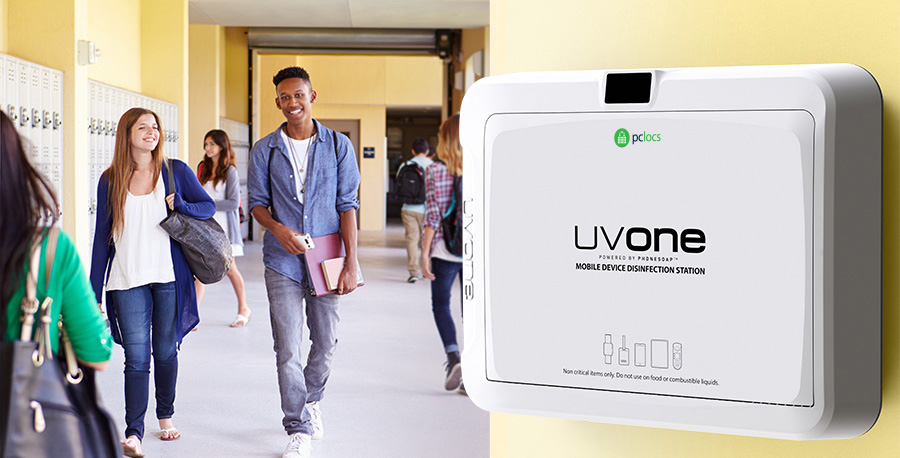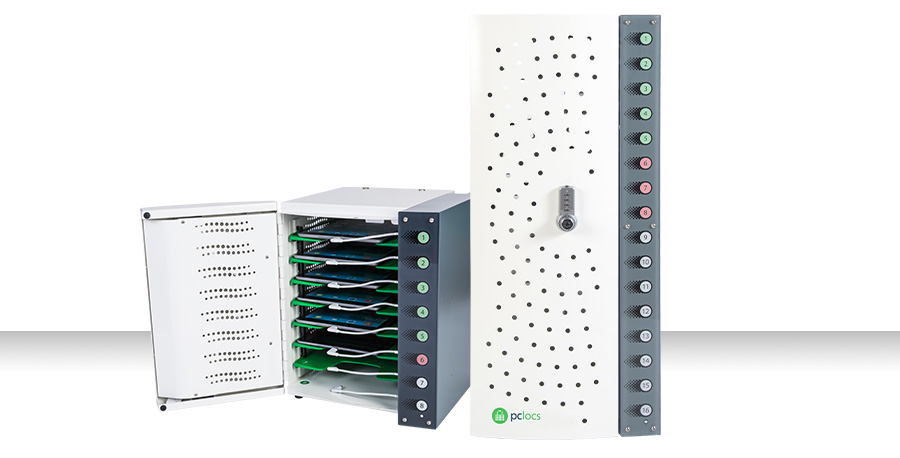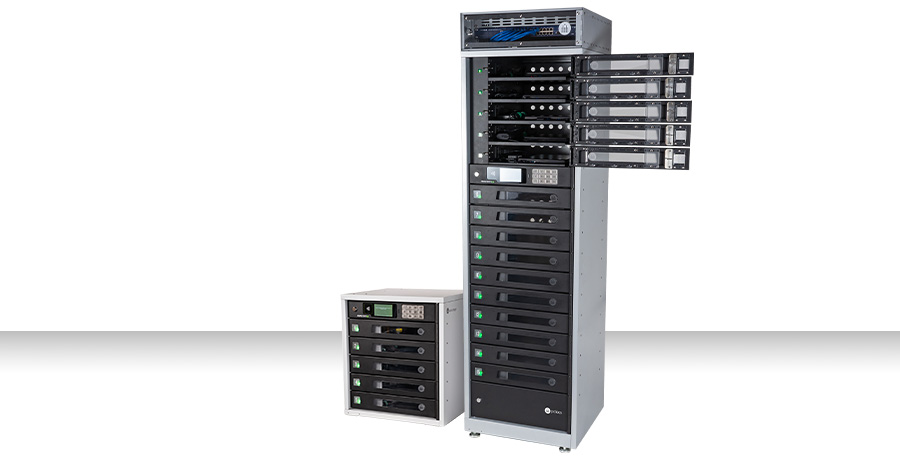How TAFE SA’s Virtual Reality Program is Revolutionising Education
04.06.20 in Blog, Industry News, Product News, Testimonials
Background
TAFE SA is South Australia’s largest vocational education and training provider with over 70,000 enrolled students and 34 campuses. TAFE SA is currently teaching over 29 trades at their Tonsley campus and is one of the leaders in Australia for its trade department.
TAFE SA recently deployed 30 Lenovo Mirage VR headsets to aid education for their Air Conditioning and Refrigeration Servicing Courses. Students have a 1:1 approach with the headsets that allows them to explore and experience high risk areas they would not ordinarily see as apprentices. TAFE SA has also mapped out the entire Tonsley Campus and will be engaging with further software enhancements to allow a freer flowing experience between VR and reality. This will be a huge benefit for current and potential students who have not had the chance to physically tour the campus.
Challenge
At the outset of the project the organisation had no formal mobile device program. As they began planning their device deployment workflow, storage of the VR headsets was an immediate concern. Initially, they attached the devices to a mobile tool trolley; however, they quickly realised the importance of charging and mobility to meet their needs. Because the headsets would travel to different campuses, secure transportation was key to meeting the high demand for training across the state.
Solution
TAFE SA originally enquired about the Revolution 16 Cart and Carrier 30 Cart, ultimately choosing the Carrier 30 Cart because of its durability, portability, and open-concept design. By removing all but one of the device Baskets, it’s possible to charge, store, secure and transport 10 headsets per Cart, with one Large Basket to house all of the accessories for those 10 devices.
Quality is a top priority for TAFE SA, which is apparent by their state-of-the-art facilities and their diligence in planning and deploying the VR headsets. This is just one of the reasons TAFE SA chose PC Locs as their storage and charging supplier for their VR headsets.
VR in Education
VR is a new and expanding technology in education. According to TAFE SA; anecdotal evidence suggests that the use of VR in the classroom increases a student’s ability to retain information by 60-70%. VR technology also allows students training in hazardous jobs to perform tasks without exposure to hazardous high-risk environments. Furthermore, mobility of technology provides accessibility to world-class facilities and training for remote students without the burden of travelling or relocating.
TAFE SA’s hands-on approach with VR technology is also transferable to rehabilitation clinics, other education providers, and the workplace. VR is transforming education, and it’s only a matter of time before pilot trials such as the one at TAFE SA will begin to trickle into different sectors.
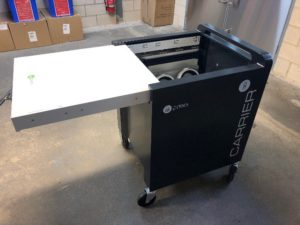 |
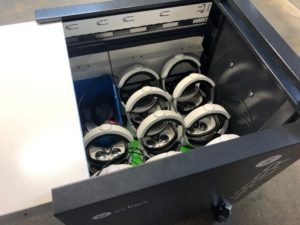 |
Download the PDF here.
Remote Learning Readiness: 5 Takeaways from a Thriving District Tech Department
18.05.20 in Blog, Industry News, Product News
If there’s one thing we’ve learned from the 2019-2020 school year, it’s that we all have adaptability within us. Here we are, navigating fully-remote learning–and just a few short weeks ago we thought “zoom” was a verb. As we’ve witnessed innate creativity and problem solving surface in so many ways during these unprecedented times, it’s helpful to take a look at the best practices that have allowed some school districts to pivot a little more quickly and smoothly than others.
David Termunde is the Chief Technology Officer for Arbor Park School District 145 in the greater Chicago area. He leads the Information Technology Department, or what’s better known as PandaTech, handling everything software, app and hardware related for their four schools and fleet of school busses. As the district’s first-ever CTO, David was hired three years ago to not only bring Arbor Park up to speed technologically, but also to future proof their tech plans.
While no one could have predicted the future for which they were “proofing”, David and his team felt well positioned when the sudden shift to remote learning struck.
Here are the top five takeaways that they believe set them up for success.
1. Jump In
In the past two years, Arbor Park made a complete shift from labs with traditional desktop computers and shared mobile devices to a 1:1 program for grades 1-8. After rigorous research and setting up a forward-thinking infrastructure, they were able to move quickly, which has helped to acclimate students and staff at an even pace with little pushback. According to David, “the extensive teacher training and professional development on new devices and platforms has certainly paid off during COVID-19.”
2. Charging is Key
While 1:1 take-home programs can help foster a sense of responsibility in students, lost and uncharged devices can be a prevalent interruption. To combat uncharged devices, Arbor Park offers a charging station in the lunchroom of the middle school. Their media center houses a PC Locs FUYL Tower, which features an Intelligent Asset Management System and 15 individually-lockable compartments. Each compartment is equipped with a power outlet and USB port, putting the tech team in total control of any device they secure – whether that’s the Microsoft Surface Go laptops used by 3rd-8th graders, the staff’s Surface Pros, the younger students’ iPads or virtually any other mobile device.
3. No More Behind-the-Scenes IT
Part of the big picture plan for the district was to give the tech team its own mascot and brand. They’re not a stale, impersonal “help desk.” They’re the Pandas. Although their desks are housed in PandaLand, you’re more likely to see them out and about in one classroom or another – fixing issues or looking for problems to solve proactively.
Equipment like the FUYL Tower plays a part in the Panda brand. It doesn’t look like a relic of the past. It’s exciting, sleek and modern, and it piques the interest of students. The team has successfully made themselves more visible and more approachable – an invaluable aspect to their 21st century IT Department. As students, teachers, staff, and parents rely more heavily on technology for learning, they also rely on their Pandas for support.
4. Technology as a Teammate
PandaTech is made up of five full-time employees. While that’s a bigger team than they’ve had in years past, they’re also managing more technology than ever before. In a district of 1,350 students, and especially during these remote learning circumstances, finding ways to let technology work harder for your team is crucial.
Typically, their FUYL Tower is used for securing charged and ready-to-go loaner devices. When students have forgotten or lost their device, they are able to independently check out what they need from a Tower.
Due to COVID-19 school closures, the Pandas have tweaked their FUYL Tower workflow to enable a no-contact pickup location for warranty replacement devices and accessory purchases. Here’s how it works. Just like an amazon locker, the FUYL Tower was relocated to a publicly-accessible location within the school. Parents are able to place tech orders from the district’s ecommerce site, and Pandas fulfill the order by placing it in a FUYL Tower compartment. Parents follow simple email instructions to unlock and pick up their order from their assigned FUYL Tower locker number the following day.
Pandas are able to view the Tower’s activity log, change pin codes, open up compartment doors and more – all remotely through the web-based management portal. David compared the FUYL Tower to “a part-time Panda” that’s always there helping the team provide the same high level of service, even when they’re not on site. Best of all, it allows them to be available and focused on e-learning support, rather than curbside pickups.
5. Keep Innovating
Arbor Park was fortunate to have a level of preparedness for remote learning that many districts did not. It’s not by chance, but instead a top-down, district-wide commitment to technology, improvement and innovation. PC Locs is a company built on that same spirit. Just like Arbor Park School District 145, we’re always looking for solutions to tomorrow’s problems so that we can continue to make life easier for our customers.
Everything your CEO & CFO need to know to launch a mobile deployment project
07.05.20 in Blog, Industry News
A CEO or CFO needs to know everything about the inner workings of their company, and most often, every large-impact business decision will need to make its way all the way up to that leader for signoff. In order to give the CEO or CFO the utmost confidence that your mobile device deployment plan will lead to company growth, you must propose a comprehensive plan of attack. Each part of the plan must address the problems it will solve and how those solutions will ultimately lead back to increased ROI or decreased costs for the company.
Improved communication: A mobile device deployment will improve communication between departments and employees, and overall will save money as communication efficiencies are implemented. In a study facilitated by PC Locs, when asked why they wanted to improve communications, respondents’ objective of fostering better communication between employees and customers reinforces not only the idea that mobilisation can benefit an organisation internally and externally, but it bridges the gap between the two. Mobilisation can help employees and customers connect more easily with each other, creating seamless interactions and retaining customers.
Faster transaction processing and better customer service: Salespeople and field agents will be able to process transactions more quickly and be able to pull up important client information at the drop of a hat. Mobile devices help field reps provide better service and lead to a higher customer retention rate, something that is imperative to making the company money. Faster transaction processing is a major contributor to the push toward mobilisation. Devices like tablets and smartphones make it easier for employees to work from anywhere, increasing productivity and responsiveness. Streamlining processes to eliminate extra overhead seeks to remove unnecessary variables that add up from a direct-cost or productivity-cost standpoint.
Furthermore, organisations can leverage mobile devices to gather data to uncover trends, optimise operations, assure compliance, track customer buying behaviour, and empower their entire operation. Ultimately, they can leverage data to generate revenue – and data is extremely valuable. If that data is inaccurate, it can send organisations in the wrong direction, such as miscommunication with customers, developing products that aren’t warranted or pricing products in a way that is unsustainable. More accurate data is vital to running a smooth operation and is a competitive advantage.
Eliminating manual paper processes: By deploying a mobile device plan, your company can eliminate manual paper processes. According to a PricewaterhouseCoopers study, estimates suggest organisations that “going paperless” can save up to ten times their paper cost by also reducing the cost of printing, toner, storage, labour, postage, and disposal. A recent report estimated U.S. businesses waste $8 billion managing paper every year. If mobile devices are leveraged to eliminate much of that manual document processing, significant savings can be realised. PricewaterhouseCoopers reports that the amount of data that businesses typically produce increases 65 percent annually, and that professionals can spend up to half their working hours looking for the information they need simply to do their jobs. Electronic processes deployed via mobile devices can mean greater productivity.
Improved efficiencies: Improved efficiencies means more productive employees. It’s no secret that mobile devices can increase employee productivity; however, if the devices are not charged and ready to use at all times, they can actually have the opposite effect. Having charged mobile devices leads to increased productivity in the workplace and can produce a significantly more positive customer experience (imagine the additional benefits you can offer a customer via a mobile device). You might also be surprised to know that 73% of organisations fail to plan how they’ll centrally charge their devices; it’s important that employees can rely on devices that the company has invested in.
How To Avoid Mobile Device Rollout Pain Points
Like any new venture, there are a few pain points that come along with a mobile device rollout.
Security and Data Safety: When you invest in a mobile device deployment, the last thing you want is for those devices to go missing. Protecting your investment protects your budget and keeps your business on track to hit its goals. Security is absolutely imperative when rolling out a mobile deployment. At the end of the day, CEOs and CFOs are likely responsible for the security of customer data and the catastrophic consequences that can ensue should a company suffer a large data breach. As many companies have learned the hard way, losing customers’ data and personal information can cost thousands, if not millions of dollars both in fines and damaged reputation.
Launching a comprehensive mobile device program is imperative to the safety of companies, stretching far beyond the mobile devices themselves. In 2017, the average cost of a data breach was $7.35 million, and those costs include everything from business disruption and revenue loss to loss of a company’s reputation. When a CEO or CFO makes the wise decision to launch a mobile device program, they need to know the steps to take to make it successful. If you are investing a large portion of your budget in portable technology, keeping it secure when not in use is the only option, because 41% of data breaches are caused by lost or stolen devices.
Remote Access for Employees: Another thing to know before you deploy a mobile device program is what exactly you are going to let your employees have access to remotely. It’s good to be upfront about which apps, websites and files will be available on your mobile devices so that IT can come up with the perfect deployment plan. It’s also important to think about which device features will be turned on or off; for example, you might want to have all cameras or microphones turned off on the devices while they’re on site so as to ensure there is no collection of sensitive data.
Understanding what’s important to your CEO or CFO is key to positioning your plan in a way that will meet their goals and objectives, and getting ahead of potential issues will yield the best results towards the company’s goals.
Learn best practices for deploying mobile devices and discover the PC Locs solutions that are right for your business–contact us today. Call 1300 725 627 or email [email protected].
How Mobile Devices Help Field Reps Provide Better Service
07.05.20 in Blog, Industry News
You may think of a Field Rep as someone who works for a utility company and comes to your house to service your cable box. However, Field Reps are common in many other industries; think mechanics, roadside vehicle service providers, public transportation agents and quality control/maintenance teams.
When Field Reps carry mobile devices, their lines of information and communication drastically open up in many ways. For example: you call your cable company for a service call. They give you an approximate time between 9am and 3pm that they might stop by, and when they arrive, they have to keep calling their headquarters or office back to get information about your account.
We have all experienced situations similar to this, but Mobile devices are now affording mobile employees a variety of benefits:
Instant Research and Information
Mobile devices give Field Reps access to a world’s worth of research on the go. They can gain insight into their customers and future leads, reflecting better on their company. Additionally, Field Reps working for organisations like energy companies and cable companies will be able to pull up important customer account information at the drop of a hat. Inventory, warranties, and numerous other documents can be at their fingertips. They won’t need to contact their call centre, and their customers won’t need to dredge up paperwork.
Information Gathering
With a mobile device, Field Reps can quickly input or update a customers email address, phone number and other data. This also allows for fast follow-ups. Mobile employees such as roadside vehicle service providers can send a quick email or make a call from a mobile device. As companies grow and start to become more data savvy, Field Reps are gathering more data on their customers every time they meet, which allows companies to provide even better customer service.
Real-time data collection is extremely useful to companies because it provides up-to-date information that can be shared throughout an entire organisation in seconds. Energy and utility company reps, for example, are able to record meter readings, upload photos of the assessed damage, etc. effortlessly and seamlessly. Real-time data entry ensures that information is recorded more efficiently and more accurately.
GPS
When mobile devices are equipped with location services, customers can know almost exactly when their Field Rep will show up. The mobile device can send a ping to the customer when the Field Rep is on their way, so they will always feel prepared and have a more accurate time estimate. On the other side, Field Reps will be able to more quickly and accurately find the place they’re going with simple GPS capabilities. Imagine if all quality control and maintenance teams used this method.
Real-time Communication
Customers and mobile employees can communicate seamlessly–imagine customers never having to phone into a call centre to be connected to their rep. If customers can connect directly with their field rep through text, chat or another messaging service, they will be impressed with their reps’ fast response times.
When you equip your Field Reps with mobile devices, it’s crucial to keep them secure and charged up. Several businesses use our charging stations so that their Field Reps can check out a charged device at the beginning of a shift, spend the day on service calls using a device, and return the device at the end of the shift. Store your Field Feps’ mobile devices with a PC Locs storage device; learn more here.
Zero-touch disinfection of mobile devices in 30 seconds
20.04.20 in Blog, Industry News
It’s well known that mobile devices are dirty. Our hands come in contact with germs on the many surfaces they touch, which we then transfer to our phones. Think about this the next time you send a text; your phone may be contaminated with streptococcus, MRSA, E. coli and more. These and many other harmful organisms have all been found lurking on what microbiologists often refer to as Petri dishes of bacteria.1 Unfortunately, it seems that nobody’s device is immune. While widely recognised for maintaining good hand hygiene, even healthcare professionals are just like the rest of us when it comes to keeping devices clean.
From nursing students to on-call doctors, numerous studies show that a high percentage of healthcare professionals carry mobile phones and tablets contaminated with both pathogenic and nonpathogenic organisms.2 However, only a small percentage are taking the time to disinfect these reservoirs of bacteria regularly. As mobile devices are now used by approximately 90% of health care workers during the workday, concerns have risen that microorganisms can easily and quickly contaminate devices from the hospital environment, patients and medical devices.3,4
These findings emphasise the importance of good hygiene practices in mobile device usage among healthcare workers. Through routine disinfection practices, the potential threat posed by contaminated devices can be significantly reduced. So how do you get busy medical specialists to change their daily behaviour and improve their mobile device disinfecting practices? To be effective, traditional wipes can take upwards of three minutes to disinfect. Not to mention the risk that it will degrade your screen over time. Perhaps that’s why the majority of healthcare workers never clean their mobile phones. Hygiene compliance is much more likely if it’s simple, convenient and visible, along with being effective. That’s where UVone can help.
Disinfect mobile devices in 30 seconds with UVone
Touchless operation
Microorganisms from the hospital environment can easily and quickly contaminate mobile phones of healthcare staff. With UVone, they can just as easily and quickly be decontaminated to limit the risk of HAIs (Hospital Acquired Infections).
 |
99.999% Bacteria Reduction* Effective UV-C light disinfects to a 5-log kill, reducing the colony to 10 MRSA bacterium after a 99.999%* reduction. UVone reduces SARS-CoV-2, the virus that causes COVID-19, by 99.99%*–which is 10x more effective than leading disinfecting wipes. With touchless sensors, users never physically touch the station, reducing cross contamination. |
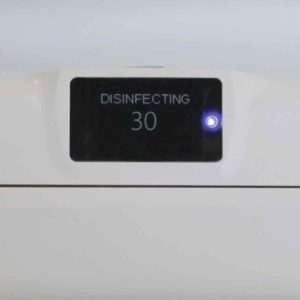 |
Rapid UV-C Technology Disinfects in Just 30 Seconds Mobile device sanitisation for healthcare workers continues to be an on-going issue for hospitals trying to reduce the spread of HAIs. UVone is specifically designed for quickness and ease of use, encouraging busy healthcare professionals to change their daily behaviour, thus increasing hygiene compliance long term. |
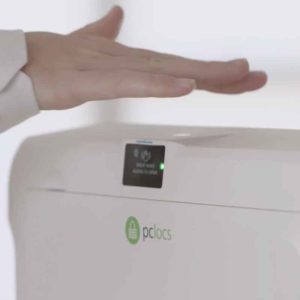 |
Touchless, Motion-Activated Door Most HAIs are transmitted by physical contact, making personal hygiene of hospital staff a critical step toward reducing the spread of infection. UVone users never physically touch the station, preventing cross contamination. |
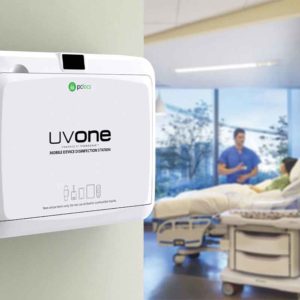 |
Convenient and Visible UVone seamlessly integrates into any environment or workflow, such as outside of operating rooms, patient rooms, nurses’ stations, or any other location that is most convenient and visible for compliance. A VESA compatible bracket is included to mount the UVone to any VESA compatible stands. A wall mounting kit is also included to mount the UVone directly to a wall. |
UVone is compatible with almost any mobile device, with or without a case and can disinfect up to three smaller devices at one time. Most healthcare-associated infections are transmitted by physical contact, so UVone offers a touchless, motion-activated door so that users never physically touch the station, preventing cross-contamination. Discover the unique advantages that UVone offers to improve patient care.
Powerful enough for healthcare, perfect for all industries.
UV disinfection for mobile devices goes well beyond healthcare facilities. Consider the last time you properly sanitised your device. UVone provides assurance that your device is 99.999% bacteria free. UVone helps mitigate the spread of viral bacteria anywhere devices are being used or shared.
Thinking beyond sanitisation
PC Locs offers a complete suite of solutions for mobile device charging, storage and security. Easily pair UVone with the PC Locs charging station or charging locker that works best for you to ensure devices are reliably sanitised, charged, and ready for use at all times.
Putnam 8 or 16 Charging Station
Putnam™ Charging Stations easily charge, store and secure 8 or 16 iPad, phone or tablet devices.
The use of institution-owned mobile devices in hospitals is growing at an exponential rate. These mobile device initiatives include a variety of use cases, such as giving iPhones to nurses and doctors to facilitate better communication, providing patients with iPads for entertainment, and leveraging iPads at registration. With healthcare becoming dependent on mobile devices, it’s more important now than ever to have devices fully charged and ready to use at all times.
PC Locs Putnam Charging Stations charge, store, secure and streamline workflow for mobile device deployments of any size. Seamlessly integrate mobile devices into your workflow with these nifty little charging stations. At a quick glance, the external lights allow you to know which devices are available for use. A centralised point of charging ensures that devices are always put back where they came from—and that they’re always charged and ready to go.
FUYL Tower 5 or 15
FUYL Tower™ Intelligent Asset Management System™ to charge, store, secure and manage assets for most mobile devices in 5 or 15 individually lockable compartments.
If you’re looking for a way to make sure your staff are reliably equipped day and night, the FUYL Tower offers a 24/7 solution. An easy-to-use digital keypad and prompts let your staff help themselves to an assigned, fully-charged laptop or device. This ease of access makes life easier for both employees and the IT workers responsible for device distribution.
Hospitals must be extremely diligent in protecting patient information. With the proliferation of mobile devices, the need to protect these devices is more critical than ever. The tower also serves an important secondary purpose as secure overnight storage for healthcare staff and providers who don’t have their own locking cabinets for laptops or other mobile devices. The small footprint of the charging unit, it can be deployed wherever staff members start their shifts, making device pickup quick and easy. Read how Erie County Medical Center is leading the way for medical mobile device deployments by protecting data and devices with FUYL Towers.
Mobile devices make hospitals run safer, faster and improve patient satisfaction scores. If you use multiple mobile devices in your establishment, we can help keep them sanitised, secure, and charged up for the critical times that your staff needs them. Learn more about UVone, the PC Locs mobile device disinfection solution.
Resources
1 Your Cell Phone Is 10 Times Dirtier Than a Toilet Seat. Here’s What to Do About It – Time
2 Resistant Bacteria Abundant on Nursing Students’ Cell Phones – MedPage Today
3 What’s Living on Your Cellphone? Prevalence of Bacterial Contamination of Health Care Worker’s Mobile Devices and Recommendations for Change as Related to Nursing Practice. Alpenglow – Binghamton University Undergraduate Journal of Research and Creative Activity, 4(1)
4 Bacterial contamination of mobile phones of health professionals in Eastern Ethiopia: antimicrobial susceptibility and associated factors – Tropical Medicine and Health
* PC Locs’ kill rate claims are based on data conducted by an accredited, GLP compliant, BSL-2 laboratory. Kill rate claims for MRSA at a 5-log kill or 99.999% are based on final GLP testing. Kill rate claims for C. Diff are at a 4-log kill or 99.99% in 60 seconds and a 3-log kill or 99.9% in 30 seconds. C. Diff results are based on final GLP testing. Real world results may vary. Testing data available upon request.





